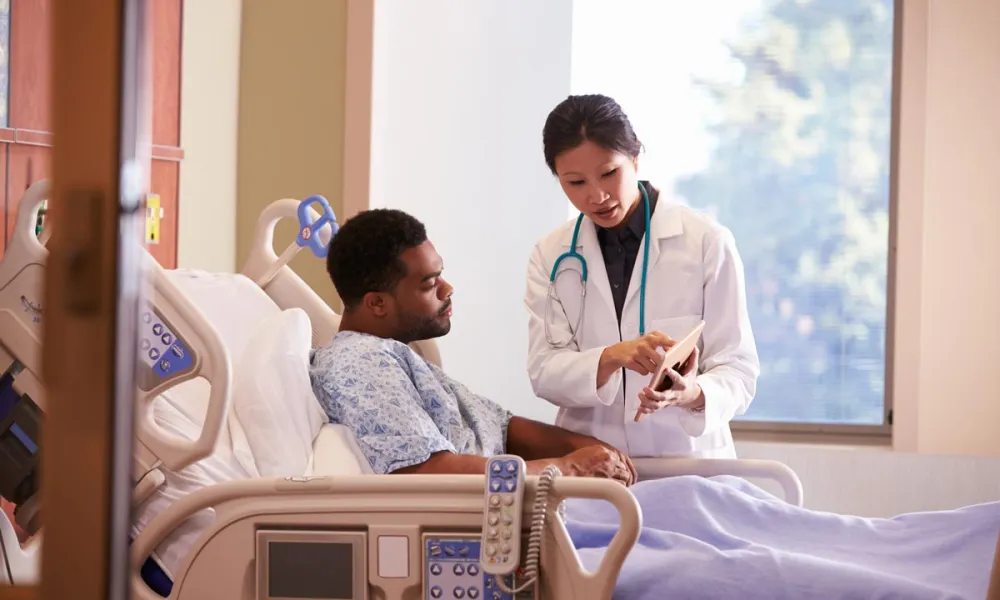
Total Hip Replacement: Post-Op Resources
Total Hip Replacement Resources
Post-Op Recovery
Living With Your New Hip
After Discharge From The Hospital
If you live alone or do not have adequate help, you may decide to go to a rehabilitation facility for a while following surgery. We will discuss options for your care prior to your hospital admission. Whether at a rehabilitation facility or at home, the following things will be important for your care.
- Your Hip Incision: You will have metal skin staples, which will be removed in your surgeon's office at your first postop visit. Thin steri-strip tape will be applied to the incision. Remaining strips may be removed after one week. If your incision has no drainage, you may shower before the staples are removed.
- Ice: You may use ice packs to your hip as often as needed following surgery. This may be especially helpful before and after your exercise sessions. Heat is not recommended, as it may increase swelling.
- Walker/Crutches: A walker or two crutches will be used for walking after surgery. Unless instructed otherwise, you may bear weight as tolerated and use the walker/crutches for 2-3 weeks, then advance to a cane in the opposite hand for 2 weeks or until you can walk without a limp.
- Physical Therapy: The therapists in the hospital will teach you an exercise program, which you will continue at home twice daily. You will also learn about precautions to take for the safety of your new hip. Much of the success of your new hip replacement surgery will depend upon how you take care of it. Outpatient physical therapy may be prescribed.
- Coumadin: Most patients will be taking Coumadin for 14-21 days following discharge from the hospital. This blood thinning medication is used to help prevent blood clots. A prescription for a specific dosage and time period is given to you at the time you leave the hospital. Your dose will be adjusted by the Anti-inflammatory medicationscoagulation Clinic at VMC where weekly blood draws will be performed. Aspirin and arthritis medications MAY NOT be taken until 48 hours after the prescription has been completed. If you take aspirin for cardiac reasons, continue to do so while on the Coumadin. Tylenol or Tylenol ES every four to six hours may be used for pain relief in addition to the prescription narcotic analgesics (commonly hydrocodone, Darvocet-N or oxycodone). Following the completion of the prescribed Coumadin, you should take one aspirin each morning for one month. Mark this on your calendar.
- Driving: You will not be able to drive for four weeks after your surgery. Although you will feel as if you are able, your insurance coverage would be in jeopardy, and your safety is of prime concern during the healing period.
- Sexual Activity: You may resume sexual activity with caution as desired following your hip surgery. If you have specific questions, please do not hesitate to ask.
- Sleeping: It is often difficult to get to sleep. We suggest trying Tylenol PM or Benadryl, purchased over the counter, to promote drowsiness.
Follow-Up Office Visits
Most patients are discharged from the hospital on the third or fourth postoperative day. Follow-up office visits are routinely advised for:
1. 1-2 weeks after surgery for staple removal.
2. 4 weeks after surgery for an x-ray and exam of knee motion.
3. 3 months after surgery for exam and assessment of activities.
4. 6 months, 1 year, and annually thereafter for x-ray and exam.
Please call our office appointment desk to schedule appointments: 425-656-5060
Prescription Refills
Refills for pain medicines may be obtained by contacting our office during business hours. It is the policy of our office that narcotic pain relievers will not be refilled or phoned in after hours or on the weekends. Prescription anti-inflammatory medicationsinflammatories may be resumed 48 hours following the last Coumadin dose.
Understanding The Risks of Total Hip Replacement
As with any surgery, there are certain risks. The following are some of the more common complications of which you need to be aware and things that we do to try to prevent them.
- Infection: There is always a risk of infection with any surgery. You will receive antibiotics in surgery and several doses after surgery to reduce this risk. The risk of infection after Total Knee Replacement is approximately one percent.
- Blood Clots: When you have surgery on the knee, circulation is impaired during healing. A blood thinner medication will be prescribed for you, which will help to keep your blood a little thinner than normal to prevent blood clots. We begin the first dose on the evening of surgery. Each day in the hospital, blood will be drawn to check your blood thinning level. Another thing that will help to prevent blood clots is to elevate both feet while sitting to prevent blood pooling in the lower legs and perform ankle-pumping exercises.
- Disloaction of the Prosthesis: There are certain positions and activities which are dangerous to the stability of your prosthesis, especially for the first few months. The therapist will teach you how to sit, rise from sitting, and turn from side to side safely, as well as other precautions. You will be given a sheet of written instructions regarding these precautions.
- Limb Length Inequality: We make every effort to equalize your leg lengths at the time of surgery. However, at times it is necessary to lengthen your leg to gain better stability after surgery. Occasionally, this will require you to use a shoe lift on your opposite shoe.
- Numbness: It is important to know that during surgery, trauma can occur to the nerves around the hip, resulting in weakness or numbness in the operated leg.
- Severe Complications: Again, with any major
surgery, there is a possibility that any of the above complications, as
well as problems with anesthesia, could be severe enough
to result in death. If there are any questions or concerns regarding these complications, please feel free to discuss them with your surgeon.
Hip Dislocation Precautions
Do not
- Cross your legs
- try to put on your own shoes or socks
- bend to the floor
- sit in low chairs or sofas
- bend your leg so that your knee is higher than your hip
- turn your knee inward with your hip flexed
Do
- Turn only with a fat pillow between your legs
- Continue your exercises as taught by physical therapy 3 times a day
Our Providers
-
Additional Resources
- Hip Replacement Overview
- Hip Replacement Implants
- Hip Replacement Guide To Surgery
- Getting Ready Before Hip Replacement Surgery
- Hip Replacement: The Day of Surgery
- Hip Replacement: Home Instructions
- Hip Replacement FAQs
- Hip Replacement
- Options for Bearing Surfaces in Total Hip Replacement
- Options for Surgical Approaches in Total Hip Replacement
- Total Hip Replacement Surgery: The Process
- Hip and Knee Replacement Videos



